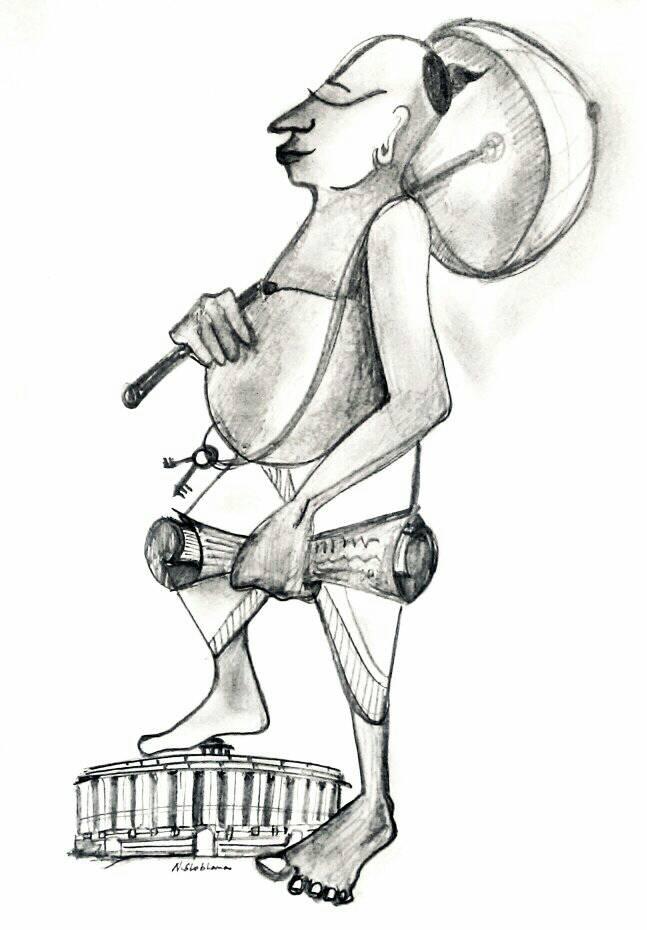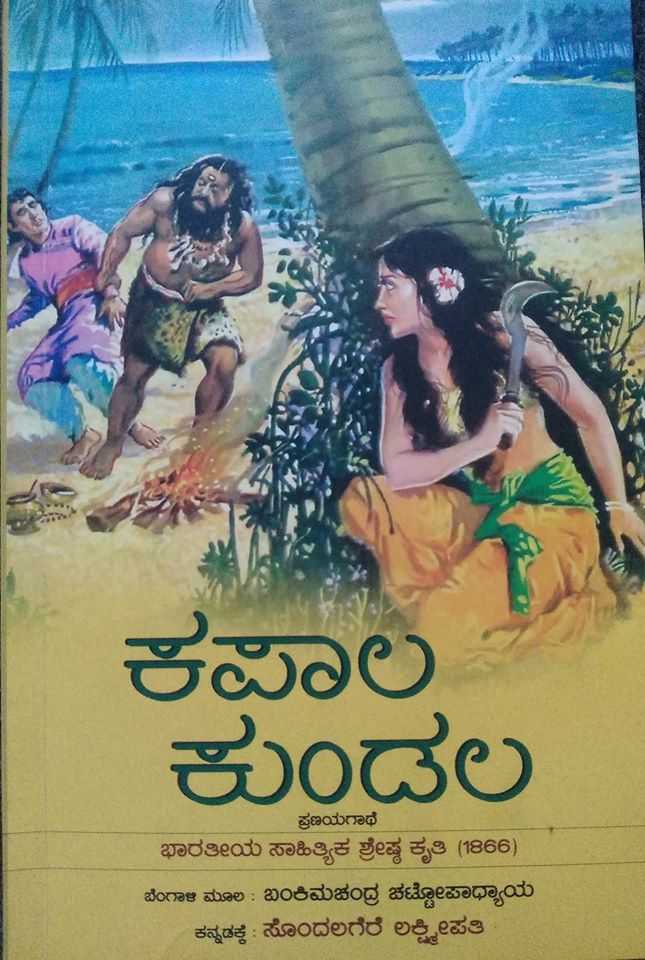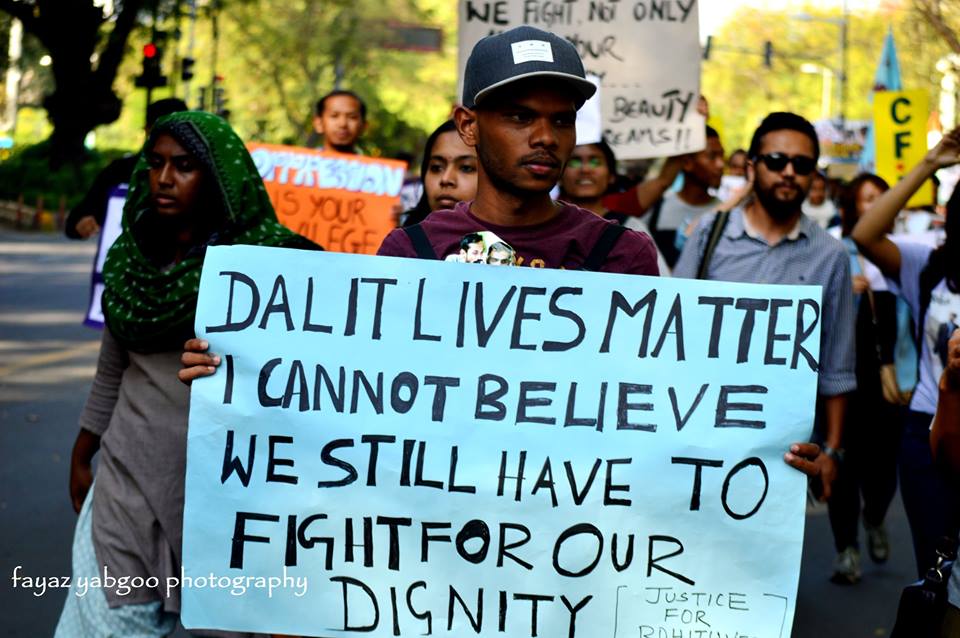N. Sukumar and Shailaja Menon
(The following article is in response to Arun Anand’s (CEO of Indraprastha Vishwa Samvad Kendra, an RSS affiliate) write-up in The Print (online 14th April 2020). We sent a mail on the same day to contest the false claims but there has been no response a week later.)

In the last few years, political exigencies have forced the RSS to widen its social base and go shopping for icons that would enable their socio-cultural agenda to flourish. From Narayana Guru and Ayyankali1 in Kerala to Rani Gaidinliu2 in Nagaland, the net has been cast wide. Amit Shah sought to reconfigure Onam as a brahmanical ‘vamana jayanti’ leading to an uproar in Kerala3. Similarly, the BJP’s overtures towards Tamil icons in giving saint Tiruvalluvar new attire with saffron robes, vibhuti and rudraksha caused a lot of ripples in the political arena4. Hence, one should not be surprised at the continuous efforts being made to appropriate one of the tallest leaders in modern India, B. R. Ambedkar-who always critiqued the religio-cultural politics of organizations like the RSS. The latest in this vein is “Why RSS considers Ambedkar as one of its own icons”5 published on Ambedkar’s birth anniversary-14th April 2020. The article is based on Dattopant Thengadi’s reminiscences of Ambedkar as mentioned in his book- “Dr. Ambedkar aur Samajik Kranti ki Yatra”.
Arun Anand’s article, purportedly based on Thengadi’s book, seeks to demonstrate the close relationship between Ambedkar and the RSS but without a single citation or any other reference to verify the facts. This sheds light on the dubious intent behind such publications wherein academic ethics have taken a back seat. A popular maxim states “Repeat a lie a thousand times and it becomes the truth …” – usually credited to Dr Joseph Goebbels, Propaganda Minister of the Third Reich. And Goebbels is the ideological patron of the RSS.
The Big Lie
Arun Anand in his article mentions that as a young RSS pracharak, Thengadi was such a blue-eyed boy of Ambedkar that he was appointed as the Secretary of the Scheduled Caste Federation when Ambedkar was its Chairman. As the name suggests, only Scheduled Caste people could be members of the Federation. If this was indeed the case, how can Thengadi, being a non-SC, be a member of the Federation? This is just one example of the entire paraphernalia of half truths. “The RSS workers worked day and night for Babasaheb Ambedkar on the directions of Guruji (the second RSS chief M.S. Golwalkar). Though Babasaheb lost this election but when he analysed the poll results he realized that the votes which he polled were much more than the total number of Scheduled Castes’ votes there. A large number of upper class voters had also voted for him. He was quite content with this outcome,” wrote Thengadi in his book.
It is indeed ironical that Ambedkar lost the election despite votes of other communities also benefitting him. The author has failed to provide any data of voting patterns or preferences so that one can understand the election results. Arun Anand argues that it was a couple of days after this defeat that he adopted Buddhism. The Bhandara bye-elections happened in 1954 and Ambedkar embraced Buddhism on 14th October 1956. An almost two year gap is dismissed as a ‘couple of days’. If Ambedkar was so pleased with the support of upper class voters, why should he convert to Buddhism and make a clean break with Hinduism? Arun Anand is very skillfully camouflaging the facts.
Ambedkar set up the Scheduled Caste Federation to focus on the issues of those castes who were considered untouchables by the caste Hindus. In fact, when the SC Federation was launched, P.N. Rajbhoj became the general secretary6. Why should he then be reticent on the Scheduled Caste Federation being caste specific as claimed by Arun Anand? “He mooted the idea of replacing it by setting up ‘Republican Party’, a new outfit with a generic name”. In his entire oeuvre, Ambedkar laid the discourse on caste at the feet of Brahminism. Further, Arun Anand mentions that Ambedkar’s Scheduled Caste Federation and Bharatiya Jana Sangh formed a pre-poll alliance and fought elections jointly in Madhya Pradesh. No sources are cited to substantiate this claim. A google search to know the real story unearthed a PhD thesis from the UGC site-shodhganga7 which debunks the author’s claim.
Ambedkar’s first formal interaction with the RSS was in Pune in 1935 as mentioned in the RSS archives. Incidentally, the site search of archives of RSS was not functional when this specific question was asked8. If Ambedkar was so enamored with RSS and Hinduism, then how does one explain his anguish, “I was born a Hindu because I had no control over this but I shall not die a Hindu”. The clear disconnect with Hinduism is dated to 19359. It is not possible to reconcile this statement with the RSS propaganda that Ambedkar was elated after visiting the RSS camp at Pune in 193910? Whom should we trust, the RSS archive or the Press Information Bureau of the Government of India?
The RSS and its ideologues have consistently sought to portray Ambedkar’s ‘fondness’ and ‘close relationship with the Sangh’. Unfortunately, in none of the articles, both in print or the web, any sources are mentioned to corroborate these yarns11. The RSS supremo, Mohan Bhagwat in a public meeting in Kanpur in 2015 tried to propagate the notion that the RSS was in close agreement with Ambedkar’s vision. “We need to take steps to minimise the gap among social communities. Ambedkar, who worked in this direction, believed in the ideology of Hinduism. He and Dattopant Bapurao Thengadi, an RSS ideologue, used to discuss about it. Ambedkar was also of the view that bhagwa (the saffron flag of the RSS) should be adopted as the national flag and Sanskrit should become the national language. Unfortunately, we couldn’t propagate his views.”12 Even a cursory glance at the history of the freedom movement would reveal that there were discussions on the semiotics of the national flag and the RSS ‘bhagwa’ was never even a footnote in the entire debate13. “Once a group of some Dalit leaders, associated with the Scheduled Caste Federation of Babasaheb Dr Bhimrao Ambedkar, asked him as to why he has appointed a Brahmin, Dattopant Thengadi, as general secretary of the Federation. Hearing this, Baba Saheb said: ‘The day anyone of you becomes a bigger Dalit than Thengadi, I will make you general secretary of the Federation.’ ‘These words reflect his trust in Dattopant Thengadi, who closely worked with him particularly from 1952 to 1956. This incident was shared by Thangadiji himself with former organising secretary of BMS Shri Krishna Chandra Mishra at Bhubaneshwar airport’”14.In another write-up in the Organiser, Shri Pawan Kumar recalled the long association of BMS founder Shri Dattopant Thengadi with Baba Saheb and also his three-hour-long discussion on the night when he embraced Buddhism. He pointed out that Shri Thengadi was an election agent of Baba Saheb when he contested by-election from Bhandara. Thengadiji was also general secretary of the SC Federation for 12 years and Baba Saheb was chairman of the Federation15.
If one were to accept these arguments given in various issues of the Organiser16, Dattopant Thengadi was secretary of the SC Federation for 12 long years (no specific dates given) but was particularly close with Ambedkar for only 4 years (1952-56). The SC Federation was active between 1942 and 1956 when Ambedkar formed the Republican Party of India. To sum up, the SC Federation existed for 14 years of which Dattopant was secretary for 12 years. Apparently, Ambedkar was aware that Thengadi is an RSS pracharak and the two of them had a long discussion the night before Ambedkar’s conversion to Buddhism. Why is there no documentation regarding such a close associate in Ambedkar’s own writings and speeches? Interestingly, Dattopant set up the Bharatiya Mazdoor Sangh in 1955, the labour wing of the RSS. There is no debate regarding the ideological crisis which made Dattopant to join the RSS, leaving the SC Federation. The narrative turns it into a seamless transfer between too diametrically opposite organizations. For Dattopant, the former turned spiritual after the death of his wife, Smt Ramabai on May 27th 1937 and started distancing himself from politics. No references are provided for such claims. Despite the tragic loss of his wife and four children due to abject poverty, Ambedkar stood firm to his political commitments and actively set up organizations to further his political and ideological vision.
Dattopant continues in an analogous vein that Ambedkar had complete information about the RSS and he also played a key role in lifting the ban illegally imposed on the RSS after the assassination of Mahatma Gandhi. Shri Guruji in September 1949 met him to formally express thanks for the support17. The ban on the RSS was lifted on July 11, 1949, after Golwalkar agreed to make certain promises as conditions for the ban being revoked. In its communiqué announcing the lifting of the ban, the government of India said that the organisation and its leader had promised to be loyal to the constitution and the flag18. Should we presume that Ambedkar was advising Guruji to communicate with PM Nehru and Home Minister Sardar Patel to lift the ban on RSS?
Mystifying Ambedkar
RSS ideologues are committed to painstakingly represent Ambedkar as sympathetic to its views regarding caste, untouchability, communism and Muslims. “About the efforts of Babasaheb to curb untouchability, Thengadiji said the removal of untouchability is basically the work of uniting the Hindu society and making it strong. The so-called untouchables are integral part of the Hindu society. Therefore, removal of untouchability is the national cause. Babasaheb had cautioned both the upper-class Hindus and the so-called untouchables to be careful of the Muslim mentality in this regard.”19 If one were to agree with Dattopant’s above statement, what explains Ambedkar’s total disenchantment with Hindu religion and his final conversion to Buddhism? He observed that Hinduism preaches separation instead of union. To be a Hindu means not to mix, to be separate in everything20. He also entered the Constituent Assembly from undivided Bengal due to the support of the Muslim League21. If he shared such cordial relations with the RSS, why did they not support his candidature?
The collateral branches of the RSS family also continue to present a distorted view of Ambedkar’s ideas and writings. Given below is an extract from another Hindutva outfit which parrots the same arguments provided by Arun Anand and on the same date (Ambedkar’s birth anniversary)22:
“In June 1953, senior RSS functionaries Moropant Pingley and Balasaheb Sathey met Ambedkar in Aurangabad, Maharashtra, where the latter asked for detailed information about the outreach of the RSS.
“Ambedkar told the RSS functionaries that if they really wanted to unite the Hindu society, they should expedite the expansion of the organisation. He told them that backwards couldn’t wait for too long, so the RSS should hurry up”, as claimed by Arun Anand, CEO of Indraprastha Vishwa Samvad Kendra, an RSS affiliate, in an article titled as Why RSS considers Ambedkar as one of its own icons, published in The Print.
Now, the question is what was the real stand of Ambedkar towards Hindutva, who wrote the ‘Riddles in Hinduism’ and shredded the Hindu faith for its accumulated caste bias, rights violation and superstitious concoctions.
In a struggling life of oppression in Hinduism along with in his challenging life as a Dalit leader in his political career and obviously in a strict social and religious opposition faced as a social reformist, Dr Ambedkar tasted the bitter truth of the transition of Hinduism ranging from its orthodoxy and liberation in various forms.
To judge the equation and variation of Dr Ambedkar and Hindutva, we have to touch the magnitude of Ambedkar’s research on Hinduism, his practical experience and interaction about it along with his venture to save the people rooted in Hinduism from the attacks of Abrahamic religions (i.e. Christianity and Islam) and foreign political doctrines like Communism.
Ambedkar wrote many books and articles on Hindu faith-religion, philosophy, scriptures, system and social changes etc. not only as the illustration of life and time, but for many introspection at several points of time.
There are so many famous Hinduism and issues related writings and works of Ambedkar as enlisted below.
1. Philosophy of Hinduism
2. The Hindu Social Order : Its Essential Principles
3. The Hindu Social Order : Its Unique Features
4. Symbols of Hinduism
5. The Literature of Brahminism
6. The Triumph of Brahrnanism
7. The Morals of the House—Manusmriti or the Gospel of Counter-Revolution
8. The Philosophic Defence of Counter-Revolution: Krishna and His Gita
9. Analytical notes of Virat Parva and Uddyog Parva
10. Brahmins V/s Kshatriyas
11. Shudras and the Counter-Revolution
12. Riddles in Hinduism
13. The House the Hindus have Built
14. The Rock on which it is Built
15. Touchables Vs Untouchables
16. Hinduism and the Legacy of Brahminism
17 The Origin of Untouchability
18. The Revolt of Untouchables
19. Away from the Hindus
20. A Warning to the Untouchables
21. Caste and Conversion
22. Who were the Shudras….. and many which were not published in Ambedkar’s lifetime nor he could complete those as per his planning to write”.
According to Upananda Brahmachari, Ambedkar acquiesced to the outreach activities of the RSS. In a bid to reconcile Ambedkar’s trenchant critique in the Riddles in Hinduism23 with the RSS’s Hindutva, Brahmachari obfuscates the issue and talks of Ambedkar’s indepth knowledge of Hinduism which helped to thwart the threats from the Abrahamic religions (Islam and Christianity) and Communism. One of the most erudite works of Ambedkar is Revolution and Counter Revolution in Ancient India24 and most of the books cited above by Upananda Brahmachari are in fact chapters from the book. Briefly, the text discusses the gradual overthrow of Buddhism and the ascendance of Brahmanical Hinduism25. However, the write-up seeks to impress upon the reader that Ambedkar’s scholarship and intellect was utilized for the service of Hindu religion.
It is by a deliberate design that various outfits of the Hindutva family are impersonating and regurgitating similar ideas on various platforms about Ambedkar’s cosy relationship with them and his vanguard action in protecting the Hindu community. For Ambedkar, religion should be judged by social ethics which he argued is absent in Hinduism. “A people and their Religion must be judged by social standards based on social ethics. No other standard would have any meaning, if Religion is held to be a necessary good for the well-being of the people”26.
Unlike the RSS’s unethical academic interpretations wherein certain words and phrases are chosen devoid of context, with no citations from various original writings of Ambedkar, the latter was meticulous in his scholarship, widely read and brought his erudition to reflect on contentious subjects. He adopted an objective approach to unravel the socio-cultural history of India especially on the vexed issues of caste and untouchability. He never glorified any historical epoch or figure and argued that “an historian ought to be exact, sincere and impartial; free from passion, unbiased by interest, fear, resentment or affection; and faithful to the truth, which is mother of history, a preserver of great action, the enemy of oblivion, the witness of the past, the director of the future. In short we must have an open mind, though it may not be an empty mind and readiness to examine all evidence even thought it be spurious”27.
~
Notes
1. PM Modi at Mahatma Ayyankali’s 152nd birth anniversary function, https://www.youtube.com/watch?v=29Q1qqHmx5M, Sept 8th, 2014, Accessed 15th April, 2020, 12.30 pm
2. Sanjoy Hazarika, “Rani Ma” Gaidinliu and How Modi Appropriated Nehru’s Legacy in Nagaland, The Caravan, https://caravanmagazine.in/vantage/gaidinliu-modi-appropriated-nehrus-legacy-nagaland, Accessed 16th April, 2020,5 pm
3. Muhammad Sabith, “Anger in Kerala as Amit Shah Turns Onam into ‘Brahminical Vamana Jayanti’”, https://thewire.in/culture/anger-kerala-amit-shah-turns-onam-brahminical-vamana-jayanti, Accessed 18th April, 2020, 10 pm
4. T Muruganandham, “Tiruvalluvar controversy: Is it BJP’s political iconography to woo Tamils?”, https://www.newindianexpress.com/states/tamil-nadu/2019/nov/06/tiruvalluvar-controversy-is-it-bjps-political-iconography-to-woo-tamils-2057508.html, Accessed 18th April 2020, 11 pm
5. Arun Anand, Why RSS considers Ambedkar as one of its own icons, The Print, 14th April, 2020
6. https://velivada.com/2015/07/17/17-20th-july-1942-in-dalit-history-all-india-scheduled-castes-federation-was-founded/, Accessed 20th April 2020, 2 pm
7. CHAPTER 3 ELECTORAL PERFORMANCE OF THE BHARATIYA JANA SANGH: 1952-1972 PARLIAMENTARY ELECTIONS, https://shodhganga.inflibnet.ac.in/bitstream/10603/112412/11/11_chapter%203.pdf, Accessed 17th April, 2020
8. http://www.archivesofrss.org/, Accessed 20th April, 2020, 12.42 am
9. Press Information Bureau, GOI https://pib.gov.in/newsite/mbErel.aspx?relid=138844, , Special Service and Features
(13-April, 2016 17:31 IST ), Accessed 20th April 2020, 12.50 am
10. For more details, refer, https://velivada.com/2019/08/21/did-dr-ambedkar-really-visit-rss-camp-pune-fake-quote-alert/, Accessed 20th April 2020, 1 am.
11. Thengadi was an election agent of Ambedkar: RSS, The Outlook, 14 OCTOBER 2004, Accessed 19th April 2020, 10 pm
12. Piyush Srivastava, India Today, https://www.indiatoday.in/india/story/mohan-bhagwat-ambedkar-sangh-ideology-rss-240342-2015-02-14, Accessed 20th April 2020, 9 am
13. Refer Ramachandra Guha, “TRUTHS ABOUT THE TRICOLOUR”, http://ramachandraguha.in/archives/truths-about-the-tricolour.html; also see THE CARAVAN, “To Whom Does It Belong? Members of the Constituent Assembly Discuss the National Flag”, 15th August 2017, Accessed, 20th April 2020, 8 am
14. The Organiser, Babasaheb & Thengadiji, 13 Nov 2019 15:04:05, Accessed 19th April 2020, 10 pm
15. Need to Understand Babasaheb Holistically, The Organiser, 25th April 2019, https://www.organiser.org/Encyc/2019/4/25/Need-to-Understand-Babasaheb-Holistically.html
16. ibid
17. The Organiser, ibid
18. When Sardar Patel Took on the ‘Forces of Hate’ and Banned the RSS, The Wire, https://thewire.in/history/sardar-patel-rss-ban-1948, Accessed 22nd April 1.20 am
19. The Organiser, op cit
20. B.R. Ambedkar, Writings and Speeches, Govt of Maharashtra, 1991, Vol 9, p 186
21. S N M Abdi, Attention BJP: When the Muslim League rescued Ambedkar from the ‘dustbin of history’ April 15, 2015, https://www.firstpost.com/india/attention-sanghis-when-the-muslim-league-rescued-ambedkar-from-the-dustbin-of-history-2196678.html, Accessed 22nd April 2020
22. Upananda Brahmachari, Dr B R Ambedkar and Hindutva, https://hinduexistence.org/2020/04/14/hindutva-and-dr-b-r-ambedkar/April 14th 2020 Part 1, Accessed 20th April 2020, 2 pm
23. Subodh Minto, A March for Reason, Round Table India, 21 January, 2019, https://roundtableindia.co.in/index.php?option=com_content&view=article&id=9539:a-march-for-reason&catid=119:feature&Itemid=132, Accessed 21st April, 2020, 3 pm. When it was finally published in 1987 under BAWS Volume 4, copies of the book were burnt publicly at a Maratha Mahamandal meeting in Amravati in January 1988. The state government withdrew the book when the Shiv Sena rioted in Bombay for the removal of chapter, The Riddle of Rama and Krishna. When thousands of Dalits staged counter-protests across Maharashtra, the chapter was reinstated, with a caveat saying the government did not ‘concur with views expressed in this chapter’. The government edition carries this disclaimer till date. Ambedkar’s fears that the book could be lost or destroyed by the Hindus is not unfounded. It has a historical basis. After all, scholars acknowledge that most Buddhist manuscripts from the subcontinent that have survived were found outside the subcontinent, owing to the efforts of Buddhist missionaries to find a safe place for them: the Brahmins sought to destroy whatever they could lay their hands on. If The Buddha and His Dhamma was Ambedkar’s gospel, Riddles in Hinduism is the kind of critique that is similar to what the Buddha himself and other traditions such as the Lokayata school undertook.
24. http://drambedkar.co.in/wp-content/uploads/books/category1/6revolutionandcounterrevolution.pdf, Accessed 22nd April 10.45 pm
25. In Political Violence in Ancient India, Upinder Singh writes of a Buddhist legend that says that “on the advice of a wicked Brahmana, Pushyamitra decided to rival Ashoka’s fame by destroying the 84,000 stupas that the latter had built”. Singh notes that archaeologist John Marshall linked the “great damage” that was “wantonly inflicted” on the famous Sanchi Stupa to Pushyamitra. Quoted by Ajaz Ashraf, Do Ambedkar’s writings about a Brahmin counter-revolution in 187 BCE hold a glimpse of India today?, https://scroll.in/article/875603/do-ambedkars-writings-on-a-brahmin-counter-revolution-in-187-bce-hold-a-glimpse-of-india-today, Accessed 22nd April 2020, 11 pm
26. B.R. Ambedkar, A Reply to the Mahatma, http://ccnmtl.columbia.edu/projects/mmt/ambedkar/web/appendix_2.html, Accessed 20th April 10 pm
27. Umesh Bagade, Ambedkar’s Historical Method: A Non-Brahmanic Critique of Positivist History, Critical Quest, New Delhi, 2015, p 9. Also refer, Anirudh Deshpande, Ambedkar: The Unsentimental Historian, Forward Press, https://www.forwardpress.in/2016/04/dr-ambedkar-the-unsentimental-historian/, Accessed 20th April 2020, 11 pm
~~~
N. Sukumar teaches Political Science at Delhi University.
Shailaja Menon teaches History at the School of Liberal Studies, Ambedkar University, Delhi.
Illustration by Nidhin Shobhana.










